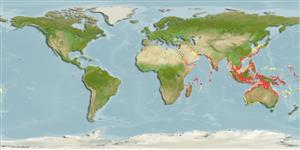Environment: milieu / climate zone / depth range / distribution range
Écologie
marin; saumâtre démersal; profondeur 20 - 60 m (Ref. 83903). Tropical
Indo-West Pacific: Pakistan, India and Sri Lanka, extending eastward to Indonesia. Recorded from the Gulf (Ref. 37588); also from northwestern Australia northward to Japan.
Taille / Poids / Âge
Maturity: Lm ? range ? - ? cm
Max length : 22.0 cm TL mâle / non sexé; (Ref. 3470); common length : 14.0 cm TL mâle / non sexé; (Ref. 3470)
Épines dorsales (Total): 8; Rayons mous dorsaux (Total): 9; Épines anales 1; Rayons mous anaux: 7 - 8. This species is distinguished by the following characters: D VIII,9; pectoral fins 13-14; gill rakers 4-5 + 14-15 = 18-20; lateral line scales 31-34; body depth at first dorsal fin origin 25-28% SL and at anal-fin origin 22-24% SL; caudal-peduncle depth 11-13% SL; maximum head depth 21-23% SL; head depth through eye 17-20% SL; head length 27-30%SL; orbit length 6.1-7.2% SL; upper jaw length 11-12% SL; barbel length 18-21% SL; caudal-fin length 26-29% SL; anal-fin height 16-18% SL; pelvic-fin length 20-23% SL; pectoral-fin length 21-23% SL; first dorsal-fin height 25-29% SL; second dorsal-fin height 16-18% SL; 5-6 weak, red or grey bars on upper caudal fin lobe (not retained on preserved fish); no bars on lower lobe, fully to partly covered with a reddish or greyish band (lost in preserved fish); a pale brown mid-lateral body stripe from behind eye to caudal-fin base (sometimes retained in preserved fish); no dark dorsal-fin tip; yellow barbels when fresh; body reddish or dark grey dorsally, whitish-rose ventrally; head with red or grey pigmentation at snout and above eyes (body may darken dorsally in preserved fish (Ref. 83903).
Inhabits coastal waters down to 100 m. Usually occurs in schools. Feeds on benthic animals (Ref. 2110).
Life cycle and mating behavior
Maturité | Reproduction | Frai | Œufs | Fécondité | Larves
Uiblein, F. and P.C. Heemstra, 2010. A taxonomic review of the Western Indian Ocean goatfishes of the genus Upeneus (Family Mullidae), with descriptions of four new species. Smithiana 11:35-71. (Ref. 83903)
Statut dans la liste rouge de l'IUCN (Ref. 130435)
Menace pour l'homme
Harmless
Utilisations par l'homme
Pêcheries: commercial
Plus d'informations
Noms communsSynonymesMétabolismePrédateursÉcotoxicologieReproductionMaturitéFraiRassemblement de ponteFéconditéŒufsDéveloppement de l'œuf
RéférencesAquacultureProfil d'aquacultureSouchesGénétiqueElectrophoresesHéritabilitéPathologiesTraitementNutrientsMass conversion
CollaborateursImagesStamps, Coins Misc.SonsCiguateraVitesseType de nageSurface branchialeOtolithesCerveauxVision
Outils
Articles particuliers
Télécharger en XML
Sources Internet
Estimates based on models
Preferred temperature (Ref.
123201): 24.1 - 28.6, mean 27.7 °C (based on 409 cells).
Phylogenetic diversity index (Ref.
82804): PD
50 = 0.5000 [Uniqueness, from 0.5 = low to 2.0 = high].
Bayesian length-weight: a=0.00832 (0.00504 - 0.01373), b=3.04 (2.90 - 3.18), in cm total length, based on LWR estimates for this species & Genus-body shape (Ref.
93245).
Niveau trophique (Ref.
69278): 3.5 ±0.37 se; based on food items.
Résilience (Ref.
120179): Haut, temps minimum de doublement de population inférieur à 15 mois (Preliminary K or Fecundity.).
Fishing Vulnerability (Ref.
59153): Low vulnerability (12 of 100).
